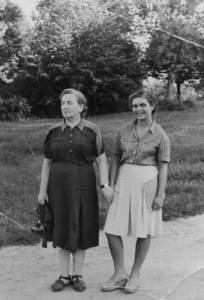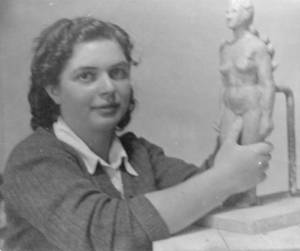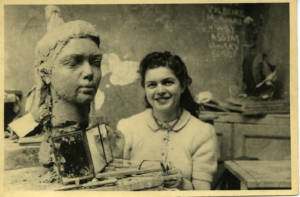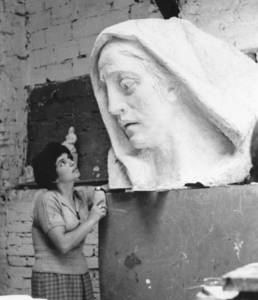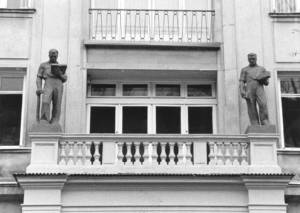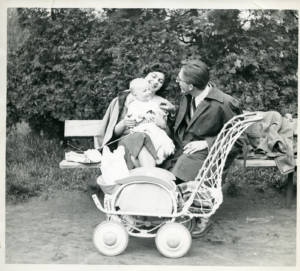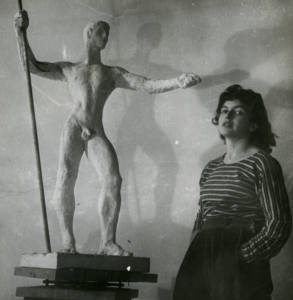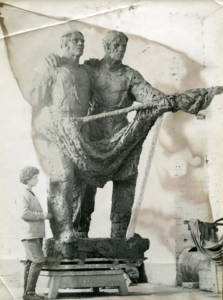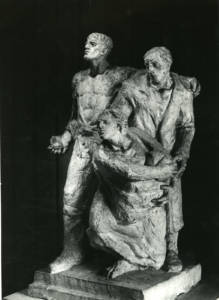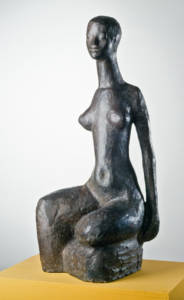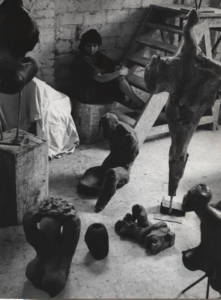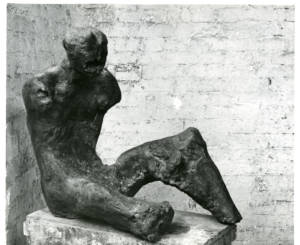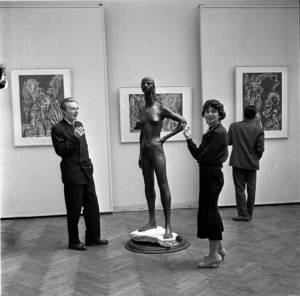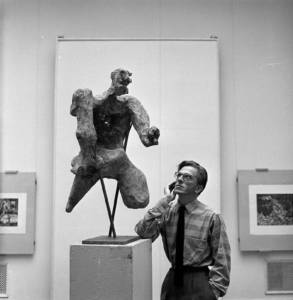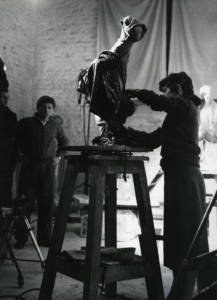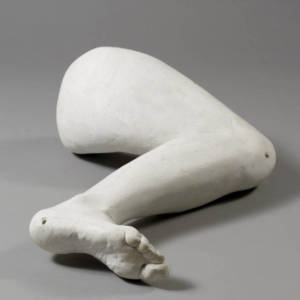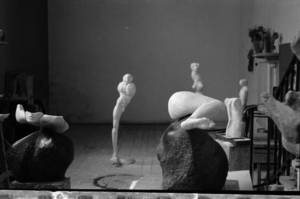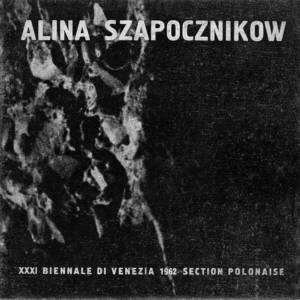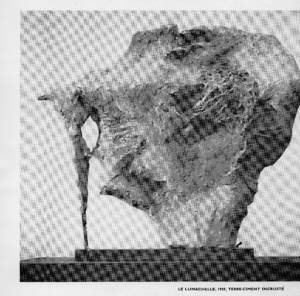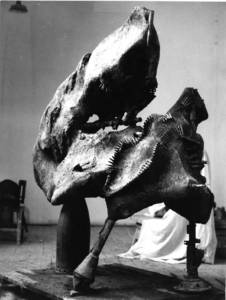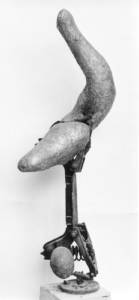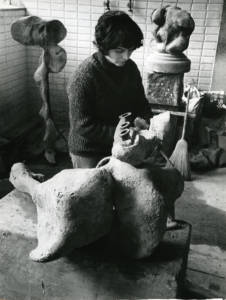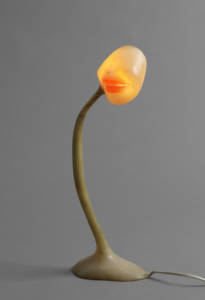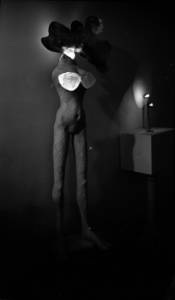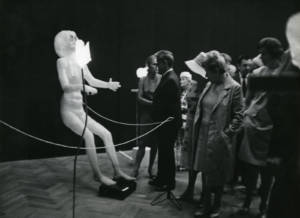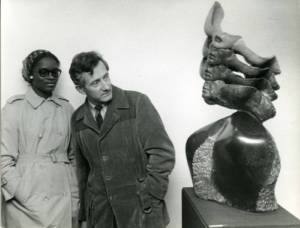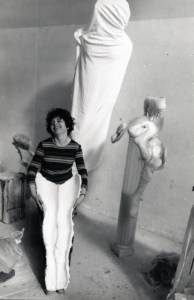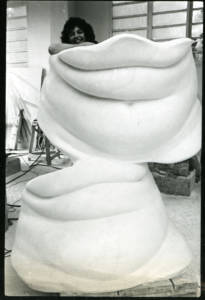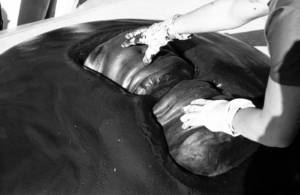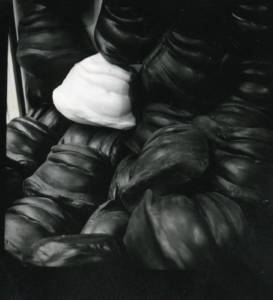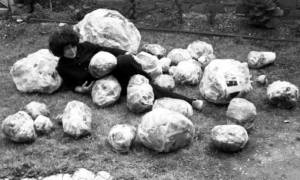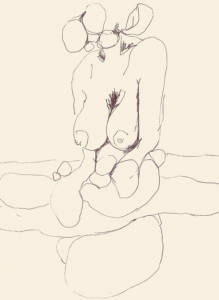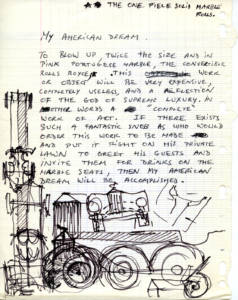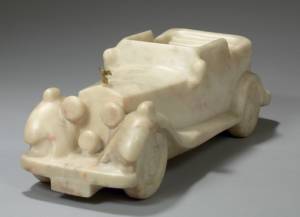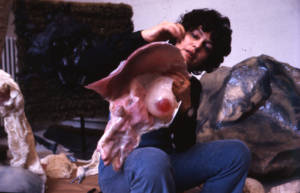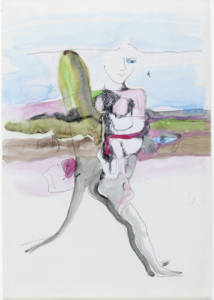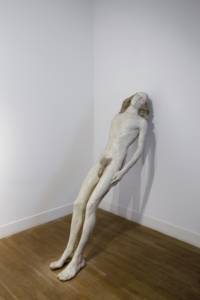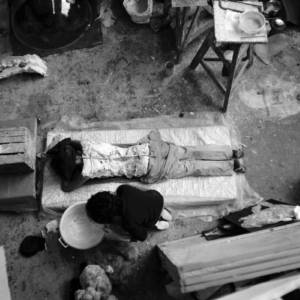
Alina Szapocznikow timeline
The Polish artist Alina Szapocznikow (1926–1973) produced a radical body of work in which she explored her own physicality during one of the most tumultuous periods in twentieth-century history.
To coincide with our survey exhibition Alina Szapocznikow: Human Landscapes, this timeline traces the development of this ceaselessly inventive artist.
Please click and drag left & right to scroll the timeline
-
- Early life
On 16 May 1926, Alina Szapocznikow is born into a middle-class Jewish family in Kalisz, Poland, daughter of Jakub, a dentist, and Ryfka, a paediatrician. When she is twelve, her father dies of tuberculosis.
-
- Second World War
At fourteen, Szapocznikow is imprisoned in the Pabianice ghetto and then the Łódź ghetto with her family. She and her mother work in the ghetto hospital. The family are later transported via Auschwitz to the Bergen-Belsen and Terezín concentration camps, and ultimately separated. Her brother dies in Terezín in January 1945.
-
- Illness
Age twenty-three, Szapocznikow is admitted to hospital with peritoneal tuberculosis, a life-threatening illness so severe it causes her to become infertile. After spending many months in sanatoriums, she is cured in spring 1950 with an experimental antibiotic treatment (Streptomycin). Her illness leaves her deeply in debt.
-
- Family life
On 12 July Szapocznikow marries Ryszard Stanisławski in Poland and together they adopt a son, Piotr, recording his birth date as 22 July 1952. The couple keep his adoption entirely secret, revealed only after Szapocznikow’s death.
-
- Public sculpture
Following the death of Stalin, the artistic climate in Poland becomes more liberal. Szapocznikow’s career in Poland continues to thrive, and she undertakes numerous competitions to design large-scale public sculpture memorials to aspects of the Holocaust and the Second World War. These include a Monument to Polish-Soviet Friendship and Ghetto-Fight, which drew on her own years of internment.
In 1955, the finished bronze Monument to Polish-Soviet Friendship is erected in the foyer of the Palace of Culture and Science in Warsaw.
-
- Towards abstraction
First Love is the earliest work to feature in Human Landscapes. It marks a transition between the heroic Neoclassical figures in her earlier work and the abstracted, fragmented and intensely personal bodies that later became her signature. With its gracefully extended limbs, First Love is a tender portrait of young womanhood.
-
- The body in pieces
Szapocznikow’s work continues to evolve rapidly towards a darker representation of the body in pieces. Exhumed (1955) also marks a political shift from earlier state-sponsored commissions towards a viewpoint critical of Soviet Communism.
An unofficial memorial, Exhumed stands in tribute to László Rajk, a politician falsely accused of Western espionage in Communist Hungary and murdered in 1949. It was originally exhibited with the title Rehabilitated, a savagely ironic comment on the volatile politics of the Eastern bloc.
-
- Artistic success
Szapocznikow’s fame as an artist grows. She holds her first large-scale monographic exhibition at the Zachęta National Gallery of Art in Warsaw and is the subject of a documentary film made by Roman Polanski for French television.
-
- Auschwitz-Birkenau memorial monument
Szapocznikow prepares a design for the Auschwitz-Birkenau memorial monument, which is highly commended by a prestigious panel that includes Henry Moore. Her proposal continues the motif of oversized, expressively contorted hands first explored the previous year in her work Hand: Heroes of the Warsaw Ghetto. The fragmentary nature of these hands anticipates her later work with decontextualised body parts.
Szapocznikow and Stanisławski divorce, and Szapocznikow begins a relationship with her future husband, graphic designer Roman Cieślewicz.
-
- Casting the body
Szapocznikow makes the first direct cast of her own body, a plaster cast of her leg. In 1965 she mounted the work on top of an unusually shaped granite base which had previously been part of her sculpture Negro Spiritualis II (1961–2). Leg was cast again in bronze in 1967.
-
- Venice Biennale
Szapocznikow represents Poland at the 31st Venice Biennale. Through the show, Szapocznikow’s work attracts the attention of leading French critic Pierre Restany, who arranges several exhibitions of her work, and with whom she remains close for the rest of her life.
Writing in the catalogue, Zdzisław Kępiński declares: ‘This bronze, this stone and this concrete acquire the breath of the skin and the softness of the flesh.’
-
- Return to Paris
Szapocznikow moves to Paris. Inspired by Pop Art and the Nouveau Réalisme group led by Pierre Restany, she combines references to the human body with readymade industrial elements, creating monstrous, mechanised forms. Drang Nach Osten (Drive to the East) (1963) includes Nazi weaponry, while Goldfinger (1965), named after the iconic James Bond film of 1964, is a fetishistic hybrid of car parts with a woman’s spread thighs, painted gold. Goldfinger wins the Copley Foundation Prize in 1966, judged by a jury including Max Ernst, Marcel Duchamp and Jean Arp.
-
- Illuminated works
Szapocznikow starts casting body parts in resin, creating series of sculptures centred around lips and breasts. Many of them have light bulbs concealed within them, transforming them into functional electric lamps for use in the home.
Although she often cast from her own body, Lampe-Bouche (Lip Lamp) works were also made from casts of friends including the actress Julie Christie. Iluminowana (Illuminated Woman) 1966-7 becomes her first full-size illuminated figure.
-
- Solo exhibition
In April, Szapocznikow opens a major solo exhibition at Galerie Florence Houston Brown in Paris, which travels to Copenhagen, Stockholm, and the Zacheta National Gallery of Art in Warsaw.
She marries Roman Cieślewicz in Paris.
-
- Belly works
Casting from her friend Arianne, Szapocznikow begins a series of Belly works that are both inviting and uncanny. Often the belly forms are repeated within a single work, lending them an increasingly abstract quality.
A monumental version carved from white Italian marble is the subject of a feature in French Elle magazine; another variation, made from polyurethane foam, is sold as a functional cushion. The use of the quickly expanding foam inspired the Expansion series, in which casts of her body parts are engulfed by amorphous black puddles.
-
- Tumours
Szapocznikow is diagnosed with breast cancer and undergoes surgery soon after. Her work develops in response: a new series, Tumours, features an agglomeration of bulbous forms. Some include crumpled photographs buried under layers of resin, others resemble misshapen heads, faces caught halfway through the act of metamorphosis.
-
- My American Dream
Invited by Pierre Restany to exhibit in New York, Szapocznikow becomes interested in conceptual art and proposes My American Dream. The project consists of a small-scale version of a 1930s vintage Rolls Royce, and the proposal for a double-life-size version carved from pink Portuguese marble.
Following an invitation to exhibit at Documenta 5, Szapocznikow seeks funding to realise the full-scale version, without success. Her approach to Rolls Royce for corporate sponsorship explains that, shown in marble at Documenta, ‘the Rolls Royce automobile would be seen in its historical presence and perspective, similar to that of the Venus de Milo.’
-
- Photosculptures
Szapocznikow’s fascination with ephemeral materials takes its most extreme form in small chewing-gum shapes formed with her mouth, photographed in a series of twenty by her husband and exhibited as Photosculptures.
Referencing the conceptualist photo-grid, the Photosculptures were also a witty allusion to Hungarian-French artist Brassaï’s 1932 Involuntary Sculpture series, reimagined, as so often in Szapocznikow’s work, through the direct imprint of the human body.
-
- Human Landscapes
Szapocznikow starts her last major series of drawings, the Human Landscapes (1971-2) after which The Hepworth Wakefield’s exhibition is named.
More highly worked than her minimal earlier line drawings, many incorporating washes of bright colour, the artist creates Surrealistic visions in which the natural environment merges fantastically with disjointed references to the human body and Szapocznikow’s own sculpture.
-
- Herbarium
Szapocznikow creates the Herbarium series, her last major sculptural gesture. In these works, Szapocznikow plays with the relationship between two and three dimensions, casting bodies and presenting them as flattened, almost forensic objects, preserved for posterity. She also creates a life-size resin cast of her son, whose reclining position echoes that of Michelangelo’s famous marble Pietà (1498–9), in which the grieving Virgin Mary cradles her dead son.
-
- Death
View videoOn 2 March, Szapocznikow dies from breast cancer, aged 47, in the Praz-Coûtant sanatorium in Haute-Savoie, France. She is buried in Montmartre cemetery in Paris.
Krzysztof Tchórzewski’s silent film, made in April 1973, documents Szapocznikow’s Paris studio only weeks after her death.
-
- Trace
View videoThree years after the artist’s death, Polish director Helena Włodarczyk creates a whimsical film, Trace, which explores the uncanny and humorous aspects of Szapocznikow’s sculpture. The film takes works from across her career out into the streets, positioning them as alien invaders to a foreign city.
Włodarczyk takes her title from Szapocznikow’s 1972 words: ‘Despite everything, I persist in trying to fix in resin the traces of our body: I am convinced that of all manifestations of the ephemeral, the human body is the most vulnerable, the only source of all joy, all suffering, and all truth.’
All images
© ADAGP, Paris. Courtesy The Estate of Alina Szapocznikow / Piotr Stanislawski / Galerie Loevenbruck, Paris
